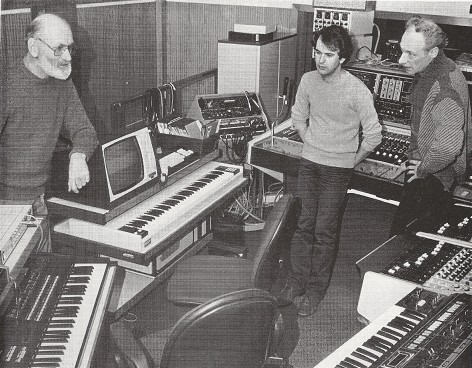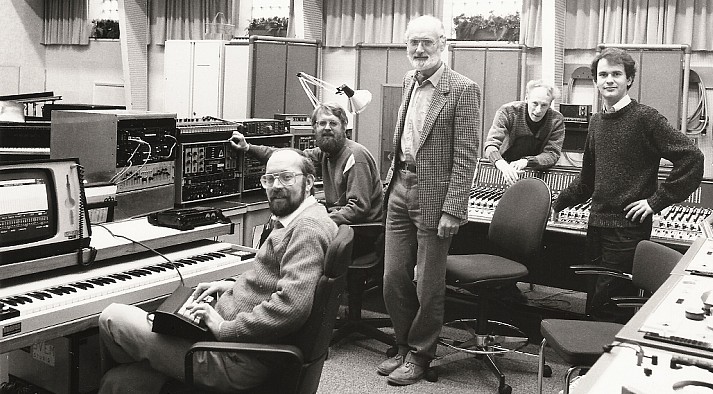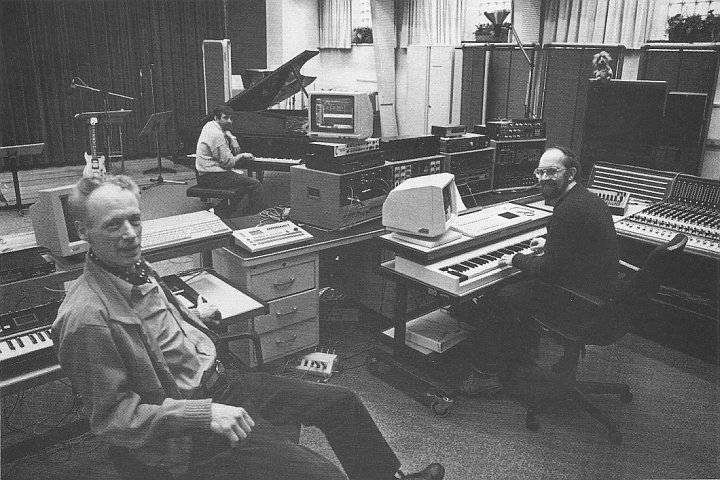|

 |
Still in the old SVEM-studio on this photo my colleagues Fred
de Beer (l), Joost Brands
(m) and Theo Rijsdijk (r) in
discussion.
We spent a lot of time in the SVEM. It was like home-base, where we
came together whenever we could, discussing the future and our
assignments, problems we encountered and how we could improve.
On the bottom left of the picture you see a Yamaha DX7, maybe it is
my own, but perhaps it is the one we bought later, when customers asked
for it so it was clear we
had to have one. |
Sometimes I came in when I had hours
to spare between assignments. You must understand that I did not just work in
the Svem. Sometimes there were 3 hours between jobs and if the SVEM was free I
could do some composing. Also when I worked in the SVEM myself I stayed a
little longer to work on my probes. This is what I call the little tunes
I made on Fairlight and you will find some on this site - I am not doing
anything else with them except declare them to the authors' rights society BUMA/STEMRA. Of course there is
the English meaning of the word probe connected to that word, but the Dutch word for "to
try" is "proberen" and there you see a second reason why
I call my little tunes "probes". (I told you I like languages!). They
are below (and "inside") the photo.
This photo shows the entire team when we moved
from the registration room of studio 2, to the studio itself.
The small Neeve mixing console from studio 5 was replaced for
one with automatic fader control and so we could have this one.
We were very happy with it.
From left to right: Herco de Boer, John van Waes, Fred
de Beer, Theo Rijsdijk and Joost
Brands. |
|
 |
| Probe
1 |
Probe
2 |
Triumph |
Probe
4 |
Probe
5 plus |
Here you can click to hear 5 different "probes" - you can also
click the persons on the photograph.
Probe 1 was later used for a program. I have no recording of Probe 3, or I
don't know where (and what!) it is. Instead I have here another kind of probe
I called Triumph.
I don't have a clean recording of Probe 5, instead this is the version I
remixed for my "Walhalla Symfonie". The first part is Probe 5 but then I added
the ARP 2500 rhythmtrack and made another composition, I originally called
that second part ProbeMCL, because I used (had to!) MCL. I recorded the
ARP-sequence on tape and had Fairlight IIx with SMPTE run in time with the
tape. Now I call this one
Probe 5 plus.
I also recall a radio play I did and they
wanted something special, so in the evening, after the recordings for the
radio play, I went to the SVEM and made a little tune for that scene, so we
could use it the next day.
It was part of a smart radioplay called "Het Vertrek" -
this Dutch word has two meanings: "The Departure" and "The
Room". In this play the main person is born (his departure from the first
"room") and he has to go from one room
to another. In those rooms things happen and he has to take tests to get to
another room. His purpose in life (as he finds out in one of the rooms) is to get to a special room to
get something (the word "precumonen" is used that has no meaning). But as he is travelling, the
building, in which the rooms exist, falls apart. At the end most of the rooms
are ruins and can not be reached. The computer that rules the building doesn't remember very
much either. Then the main
person starts a new life, because of course that's what it is: the life of a person who
travels from room to room. And the end suggests we also travel from building
to building. It is an impressive piece. Director was Willy Brill and
the writer of the piece Ingrid van Delft. If I listen to the whole play I just
can't turn away from it.
In 1986 Akai came with its
S-900 sampler. It was 12 bits and that was better than the Fairlight we used
in the SVEM. The Fairlight IIx was only 8-bits!. But... the Fairlight III was
already there, costing a lot of money, but it was a 16-bit sampler and many more new
features, including audio editing. We were impressed but didn't have the
money..... yet
In 1986 was the Firato and we were told to represent the SVEM there. I refused. My
argument was that we were there presenting the Dutch broadcasting corporations
with an 8-bit machine, and the next stand could be the Akai-stand, with it's better sounding and 20 times cheaper S-900
sampler. I would feel foolish representing a studio that was out of date! A year later two new Jingle Production Facilities were built for the
NOS where the S-900 sampler also found a place. I had to teach some
technicians how to use it, but I wasn't allowed to work there myself -
something I don't understand to this day!
Our chief who got us the Neeve mixing console, managed to get us the new
Fairlight III as well. I still don't know how he did it, but he did. And we
were as happy as children.
The next photo is the only one I have that shows the studio with the new
Fairlight III.
|

Here you see on the foreground Theo
Rijsdijk and I am sitting behind Fairlight III. In the back behind the grand
piano
you see Imre
Somogyi, a producer of the
NCRV who entered a whole new career in 'reading
toes'.
|
The Fairlight III came and we had to present it a week later at the Firato,
which was an annual event in Amsterdam (RAI) on Home Entertainement.
Theo, Fred, John, Joost and I worked hard to study the new Fairlight and we were in the
studio everyday, all day for a week.
|


|